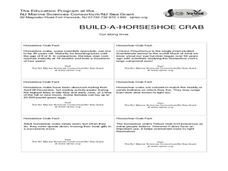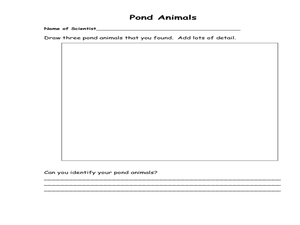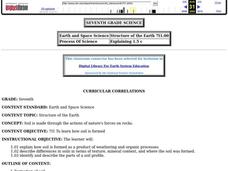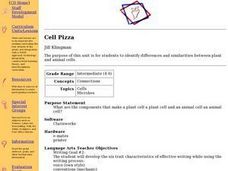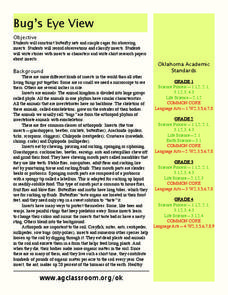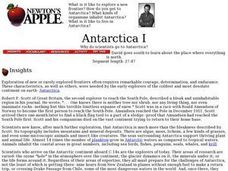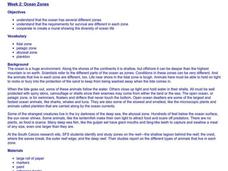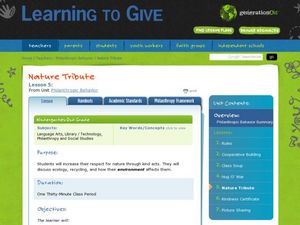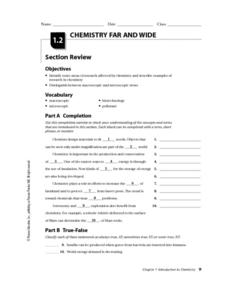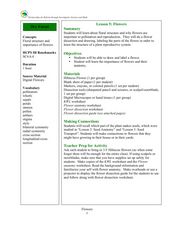Curated OER
Build-A-Horseshoe Crab
Students discover many facts about horseshoe crabs. Students identify the main body parts of horseshoe crab. They explore the habits of the horseshoe crab and their importances to the ecosystem. Adaptations for younger students are...
Curated OER
Pond and Pond Organisms
Students explore pond ecosystems. In this pond organism activity, students will use pond water and a plastic bad in order to locate and identify freshwater organisms. The activity is designed for younger grades, but...
Curated OER
Cell Factory
Learners examine the basic structures and functions of cells. They design and construct a factory cell model where each factory part corresponds to a cell part.
Curated OER
Soil Formation
Seventh graders investigate how soil is formed. They analyze types of soil samples, examine soil using a magnifying glass or microscope, complete a chart, conduct a soil and plant experiment, and construct a soil profile.
Curated OER
An Introduction to 'Opae 'ula
Students examine the 'opae 'ula. In this science lesson, students observe a live specimen and identify the major body parts. Students construct habitat jars and observe the 'opae 'ula behaviors.
Curated OER
Cell Pizza
Students identify parts and functions of microscope. Students watch video, Cells and Life about cell parts with actual pictures and actual cells. Students discuss video and identify parts of the cells that animals and plants have in...
Curated OER
Bug's Eye View
Young scholars explore biology by writing fictitious stories in class. In this insect life lesson, students identify many different types of insects in the animal kingdom and the classifications they fall into. Young scholars collect...
Curated OER
Fossil Impressions of Ancient Life
Students make a mold using Plaster of Paris and then make a cast using that same mold. They pick a fossil and describe how it looks. They write a fictionalized story about its life, or burial. (
Curated OER
CSI: Native America
Students discuss the murders of Native Americans in Indiana. In groups, they research and make drawings of the scene as if they were part of a CSI team. They complete any needed experiments to help them solve the crime and create a...
Curated OER
A Bug's Journey
Students examine the artwork of John Baldessari that was inspired by a 16th century drawing of a beetle. They analyze a drawing of a beetle, discuss the insect's characteristics, and write a story from the perspective of a bug. Also,...
Curated OER
Matter: All That "Stuff"
In this chemistry learning exercise, learners learn about matter, including atoms, electrons, protons, neutrons, compounds and chemical properties. They use this information to answer the 10 questions on the learning exercise. The...
Curated OER
Limu in Your Lunch
Young scholars explore various types of algae found in Hawaii. For this science lesson, students research species of the three types of limu and identify various uses. Young scholars explore products that contain limu.
Curated OER
Outbreak!
Students study and research drug-resistant bacteria and the use of antibiotics. Through the use of the internet, and other resources, students gather information and create a board game. They discuss bacteria, antibodies, antibiotics...
Curated OER
BIoluminescence
High schoolers investigate the concept of bioluminescence. They use dinoflagellates in a lab situation to study photosynthesis. They conduct research into the concept using a variety of resources. Also the class is taken on a field trip...
Curated OER
Antarctica I
Students explore exploring and expiditions then simlate their own on campus. They divide into small "expedition groups." Have each team report back to the class about their expeditions, using written, oral, or videotaped presentations.
Curated OER
What Do Trees Do for Dinner?
Students investigate how trees produce their own food. They examine chlorophyll cells with a microscope, analyze a cross section of a log, determine how old the tree was, simulate the distance of the roots, and create a play.
Curated OER
Ocean Zones
Students create a mural showing ocean zones and the diversity of ocean life. They use reference books to create a list of plants and animals that would live in each zone.
Curated OER
Barn Owl Pellet Lab
In this lab worksheet, students dissect a barn owl pellet then identify the different small animals found in the owl pellet. Using class data they calculate percentage present as well as complete 8 post lab questions.
Curated OER
Light and Vision
In this light and vision activity, high schoolers will review the characteristics of light including how the eyes use light to see. This activity has 9 fill in the blank, 8 true or false, 9 multiple choice, and 1 short answer question.
Curated OER
Nature Tribute
Students explore parts of nature. In this environmental lesson, students discuss how their actions can affect the environment and design a plan to clean up a specified area. Students practice good hygiene during the cleanup project.
Curated OER
Chemistry Far and Wide
In this chemistry worksheet, high schoolers fill in 10 blanks with the appropriate term, they determine if 4 statements are true or false, they match 6 terms with their definitions and they answer 3 questions. Topics include areas of...
Curated OER
Let's Learn About Lettuce
Students learn more about lettuce. In this agriculture lesson, students listen to their instructor lecture about the history of lettuce. Students then participate in an activity that requires them to compare and contrast iceberg lettuce...
Curated OER
Dry Forest: Flowers
Pupils explore botany by examining diagrams. In this plant reproduction lesson plan, students define a list of plant vocabulary terms and identify plant anatomy from a diagram. Pupils complete several plant activity worksheets and study...
Curated OER
Pollen Tube Growth
Students demonstrate the proper usage of the compound and dissecting microscopes. They identify the parts of a flower and the functions of the flower parts. Students describe the process of gamete formation and fertilization in a flower.
